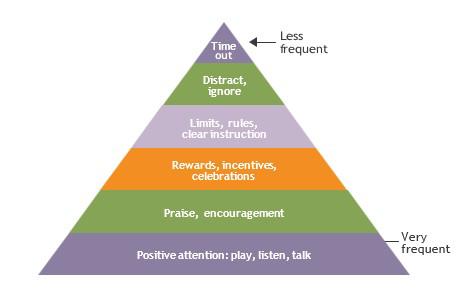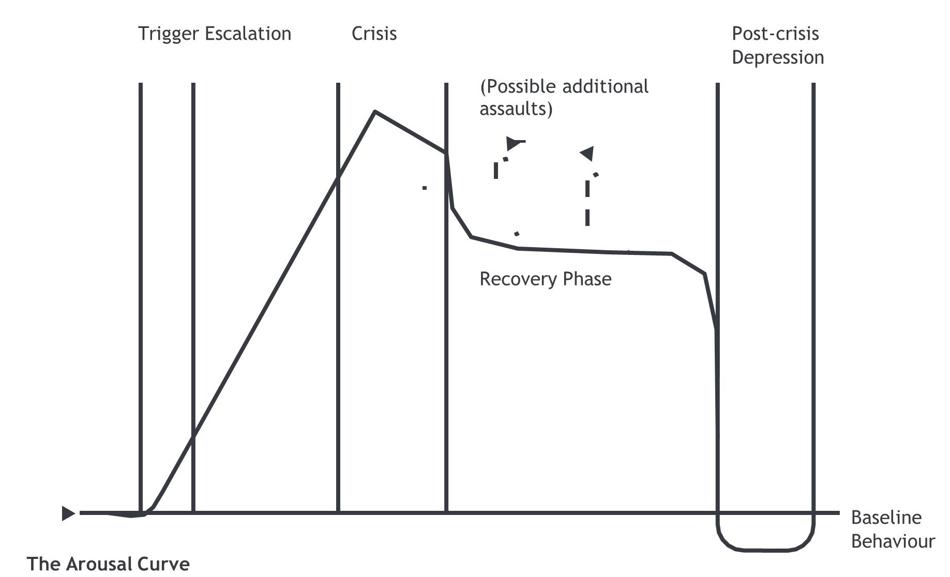What is distressed or Physically Aggressive Behaviour?
Distressed or Physically Aggressive Behaviour (PAB) can be defined as: ‘behaviour causing or threatening physical harm towards others’.
There are two types of PAB to reflect differences in the function of children’s behaviours; they may be communicating a need or responding to others when feeling angry or fearful (Kaye & Eardley, 2011). PAB does not include behaviours that are typical for a child’s stage of development within the early years (e.g. tantrums, refusals, biting can be typical up to around 3 years of age).
Positive behaviour management
How do you create a positive environment? How do you make children feel important and loved? Positive behaviour management begins with positive attention and praise.
Children are dependent on the adults around them to teach and model wanted behaviours and motivate them to engage in those behaviours, through high levels of praise, encouragement and rewarding wanted behaviours whenever they occur, by adults looking out for, labelling and commenting on desirable behaviours. Your attention is often the biggest reward, so provide it often when unwanted behaviours aren’t occurring. It is also really important to give clear limits and rules.

Why might some children display distressed behaviours?
- ‘Proactive PAB’: Understanding behaviour as communication
Understanding why a child is displaying distressed behaviour can enable you to provide them with effective support and reduce the risk of the behaviour reoccurring. Some children display behaviours as they serve a function and help them to get their needs met. These needs are often difficult to express and so their behaviour serves as a method of communication. Functions of behaviour include expressing emotion/emotional regulation; gaining social interaction with adults or peers; obtaining things or events; avoidance of people, situations, events, activities etc.; and trying to gain control or feel secure.
It is a good idea to observe the behaviours, perhaps using an ABC or STAR chart, in order to pinpoint the different times and situations when a child’s behaviour changes. This is a helpful way of understanding what the child’s behaviour is communicating. This can help practitioners and parents/carers to distract the child before the need arises, or to help identify what skills the child needs teaching to provide them with an alternative method to get their needs met. Further support can be provided by your SENCO.
- ’Reactive PAB’: Understanding Fight/Flight and the Arousal Curve
Flight/flight is the body’s automatic and unconscious response to a perceived physical or psychological threat/danger within the environment. When this happens, the emotional part of the brain takes over and so we are unable to make reasoned or informed decisions. Some children may therefore display PAB as a result of their body’s fight/flight response. Some children who have experienced trauma are more likely to enter the fight/flight response and may appear to become emotionally heightened more quickly in response to certain situations. The arousal curve (image overleaf) is commonly used to depict the fight/flight response and it can be helpful to create a plan for how you may support child at each stage of the curve (see the following table). Further information about the flight/flight response can be found in the signposting section below.
The Arousal Curve

Open each section for further exploration of behaviours that may be seen and strategies that may be used at each stage.
Creating a calm environment
Developing an emotionally friendly approach to wellbeing can be supportive in creating a calm environment that may reduce the likelihood of children displaying PAB (you can contact the Educational Psychology Service edpsych@bury.gov.uk or the Emotionally Friendly Schools team EFS@bury.gov.uk for further information about Emotionally Friendly Settings). Creating a calm environment can also help in promoting feelings of safety in setting. Things that can help to achieve this include the below (please also see the SEMH section within the main EY SEND Thrive tool):
- using behaviour management techniques that help children to understand and manage their emotions such as Emotion Coaching (see appendix);
- creating predictable routines (e.g. through use of visual timetables);
- use of softer lighting/natural light and reducing brightly coloured displays;
- regularly engaging in class mindfulness or yoga;
- and creating calming corners or sensory spaces.
De-escalation and Proactive Support
In addition to the above, some children identified as being more likely to display PAB may benefit from: direct teaching of emotional regulation skills and relaxation techniques; the identification of a specific Key Adult with whom they can build a supportive and trusting relationship; the use of Social Stories in relation to PAB; and the development of an agreed planned response to PAB developed with the child’s parent/carers, emphasising de-escalation and preventing PAB (e.g. RAMP).
Developing a planned response
There may be occasions where despite using de-escalation strategies, children may continue to move up the arousal curve and display PAB. When this happens, adults may be required (in extreme circumstances) to use positive handling techniques. These should only be used when absolutely necessary and for as short a time as possible, in order to keep the child and others safe.
It is important there is a planned response that is agreed with the child’s family and consistently applied by all staff when responding to the child’s behaviour throughout the day. This should consider all stages of the arousal curve and is sometimes called a Reducing Anxiety Management Plan (RAMP). It is important to involve relevant professionals and support services at an early stage when exploring the underlying reasons for a child’s PAB in setting, which may include:
- SENCO
- Speech and Language Therapist
- Educational Psychologist
- Paediatrician
- Social Care (Children with Disabilities Team)
Risk Assessment prompts
Most children who display PAB can be managed safely in settings with appropriate levels of support and clear risk management plans. If you are concerned that a child is showing PAB, please refer to the prompts below to ensure you are involving the right people and services to assess and manage the risk appropriately:
- Have you developed a calm and emotionally friendly setting environment?
- Does your setting’s behaviour policy outline a planned and approved response across the setting for responding to PAB? Is this policy well understood and consistently applied by all staff?
- Have you considered the functions underlying the child’s behaviour and provided them with alternative methods to communicate and meet these needs?
- Have you tracked the occurrence of PAB, identifying antecedents and consequences (e.g. using the ABC Chart or STAR approach), to identify any potential triggers to this behaviour?
- Have you considered the arousal curve and how you can utilise de-escalation strategies with the child to prevent PAB?
- Where PAB is displayed, are you using a multi-agency approach to inform a holistic assessment in order to provide a support plan for the child? Have you made referrals to external services e.g. Early Years SEND Team, Speech and Language Therapy, Paediatrician as appropriate?
- Have you considered the immediate safety of children and staff? It is important to be guided by relevant national legislation and guidance; organisational policies, procedures and guidance; human rights; the identified risks or needs of the child; and the potential or real risks to others?
- Have you considered how to support the wellbeing of staff who regularly work with the child displaying PAB?